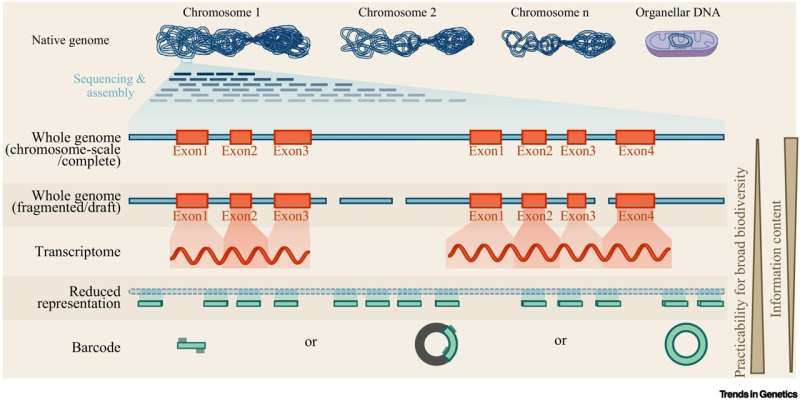This article has been reviewed according to Science X's editorial process and policies. Editors have highlighted the following attributes while ensuring the content's credibility:
fact-checked
peer-reviewed publication
trusted source
proofread
Genomic analyses provide important insights for conservation management

Conserving nature's biodiversity is one of the great challenges of our time. To develop strategies and effective measures, well-founded scientific analyses, and concrete information for the actors in nature conservation are needed. The field of biodiversity genomics can make an important contribution here: genomic data of species, species communities and entire ecosystems provide insight into characteristics, adaptive abilities, relationships and evolutionary developments.
This data should always be considered in far-reaching assessments and decisions in nature conservation management—this is what an international team of scientists from Frankfurt, among other places, advocates in a new publication in the scientific journal Trends in Genetics.
The current biodiversity crisis has devastating consequences for the functioning and health of ecosystems, the evolutionary heritage and the adaptive potential of species. Ultimately, it also threatens humanity. Although genetic diversity has long been recognized as fundamental to all levels of biological organization—from individuals, populations and species to communities and ecosystems—genomics is often neglected in biodiversity assessments and conservation measures, the scientists argue in their article. They see reasons in limited knowledge transfer, limited interdisciplinary cooperation and the lack of corresponding international guidelines.
To demonstrate the numerous advantages and possible applications of genomic data, the team gives an overview of the most important approaches and applications of biodiversity genomics. While the biodiversity of entire ecosystems can be analyzed by means of so-called DNA metabarcoding, the level of detail in the investigation of individual organisms can be adapted to the respective issue in species conservation.
"For example, genomic data can be used to determine the ability of a species to adapt to changing environmental conditions much more realistically. Parameters that are important for conservation management, such as inbreeding or gene flow, which is the exchange of genetic material within or between populations, can also be depicted very reliably by analyzing whole genomes.
"With our publication, we would like to promote cooperation between researchers from the fields of conservation and biodiversity genomics for guiding a new era of conservation genomics in the Anthropocene—the age in which humans have become one of the most important factors influencing biological, geological and atmospheric processes on earth," explains Dr. Kathrin Theissinger, a scientist at the Senckenberg Society for Nature Research and the Hessian LOEWE Center for Translational Biodiversity Genomics (LOEWE TBG) and one of the first authors of the publication.
According to the researchers, data from reference genomes, i.e., comprehensively analyzed genome information of a species, provide particularly reliable insight. "We want to contribute to making reference genomes for numerous species from the entire tree of life readily available and usable. This treasure trove of data will make a crucial contribution to assessing, maintaining, or restoring the biological diversity of our planet," says Miklós Bálint, Professor of Functional Environmental Genomics at Senckenberg, the University of Giessen and LOEWE-TBG.
"For the goal of deciphering and understanding the genomic basis of this diversity, Senckenberg and the LOEWE Center TBG offer excellent conditions, especially also for the production of reference genomes of a wide range of species."
Consortia have formed in recent years to provide these. Among them is the European Reference Genome Atlas (ERGA, https://www.erga-biodiversity.eu) initiative, whose members are also involved in the article. The ERGA consortium has set itself the goal of forming a transdisciplinary and cross-border community of experts. ERGA is the official pan-European branch of the Earth BioGenome Project (https://earthbiogenome.org/), a global initiative with the goal of sequencing and cataloging the genomes of all currently described eukaryotic species on Earth over a ten-year period. The LOEWE Center TBG is a member of both initiatives.
More information: Kathrin Theissinger et al, How genomics can help biodiversity conservation, Trends in Genetics (2023). DOI: 10.1016/j.tig.2023.01.005
Journal information: Trends in Genetics



















